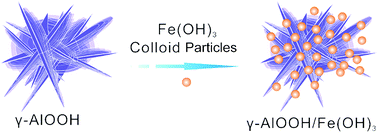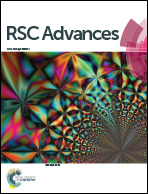Monodispersed hierarchical γ-AlOOH/Fe(OH)3 micro/nanoflowers for efficient removal of heavy metal ions from water
Abstract
Many nanomaterials have been reported for the removal of toxic inorganic metal ions. Some conventional micro- or nano-structured adsorbents are subject to serious aggregation. Here, well-dispersed, Fe(OH)3 colloid nanoparticles have been effectively deposited onto the surfaces of hierarchical γ-AlOOH nanostructures to form γ-AlOOH/Fe(OH)3 with hierarchical structures via an electrostatic attraction without forming large aggregates. The monodispersed γ-AlOOH/Fe(OH)3 with hierarchical structures have high specific surface areas and large pore volumes, which are used as adsorbents to remove anion species of As(V) and Cr(VI) from aqueous solution. The maximum capacities of the monodispersed γ-AlOOH/Fe(OH)3 with hierarchical structures for As(V) and Cr(VI) in this study are determined at 43.8 mg g−1 and 13.1 mg g−1, respectively, which are higher than those of the other metal oxide nanostructures reported to date. In addition, the adsorption rates of As(V) and Cr(VI) onto the monodispersed γ-AlOOH/Fe(OH)3 with hierarchical structures are rather fast. The γ-AlOOH/Fe(OH)3 hierarchical micro/nanoflower structures show high adsorption capacity for removing the anion species of As(V) and Cr(VI), demonstrating a promising potential in environmental remediation.


 Please wait while we load your content...
Please wait while we load your content...